The instruments of Big Bang Orchestra 2.0 provide two different kinds of Presets, accessible by clicking on the icons “Flow” resp. “Precision” in the Synchron Player’s top bar. Flow Presets offer an intuitive, graphic approach to the library’s contents, with instrument, articulation, and sound parameters displayed in a single window. These are treated in the manual on hand.
On the Flow Browser page, you can see the available collections in the top bar. In the main panel below, click on “Start Tour” to step through explanations of the different Flow elements and parameters. Alteratively, when you have opened a preset, you can click on the Info Hub icon in the upper right corner of the instrument field, where you can start the tour or connect to our online instrument academy.
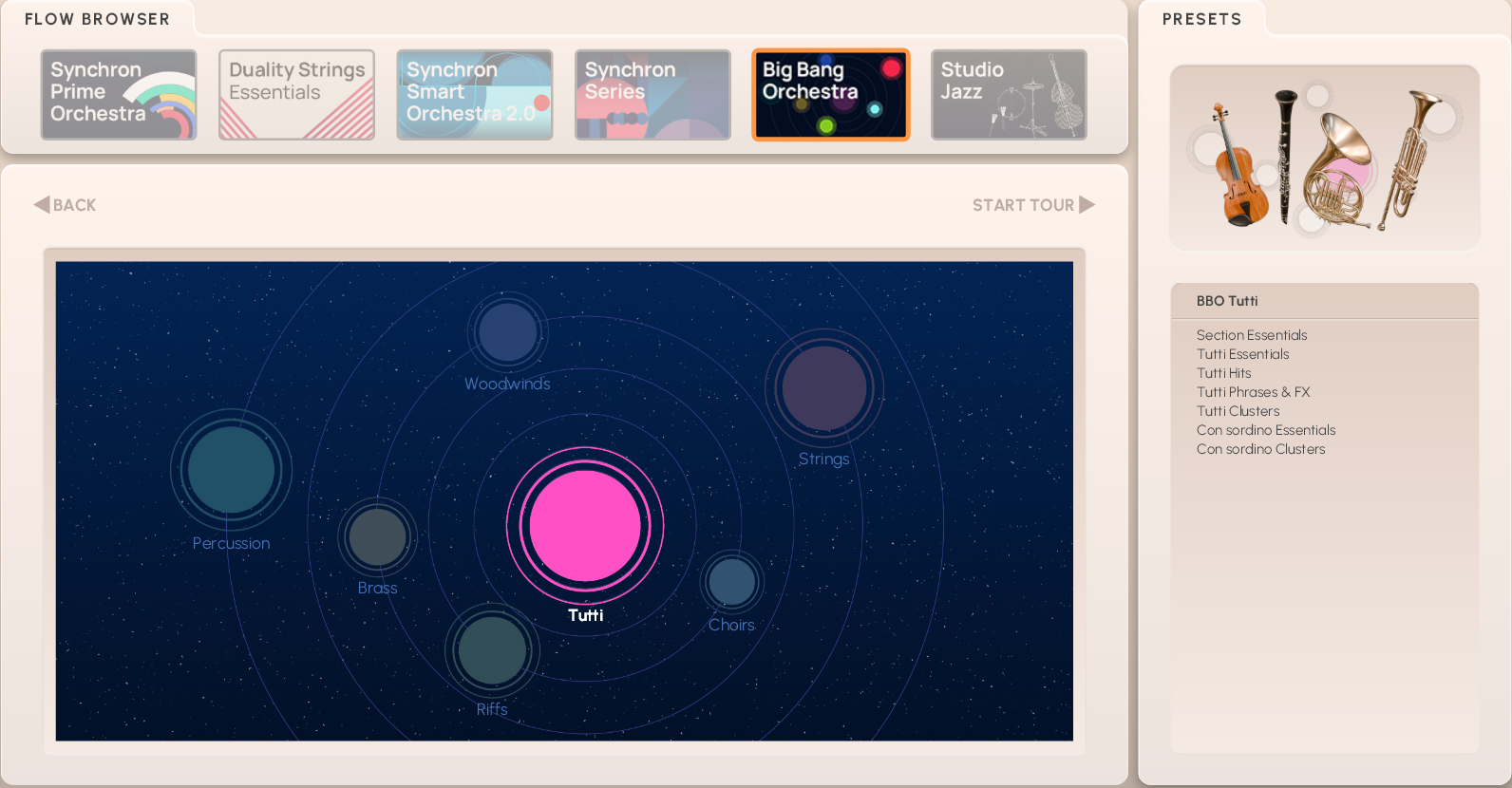
In the main panel, the currently active instrument group ist highlighted. To change the preset list displayed in the right-hand panel, click on the icon of the instrument group you want to work with. Then double-click on a preset name to load that preset.
Flow Presets give you instant access to the most important parameters of an instrument, its articulations, and general sound settings. Accordingly, the display is subdivided into three panels. The left-hand one holds instrument specific and tonal parameters. The middle shows the available articulations and often special microphone faders for individual instruments; and the panel on the right side contains all sound-related parameters.
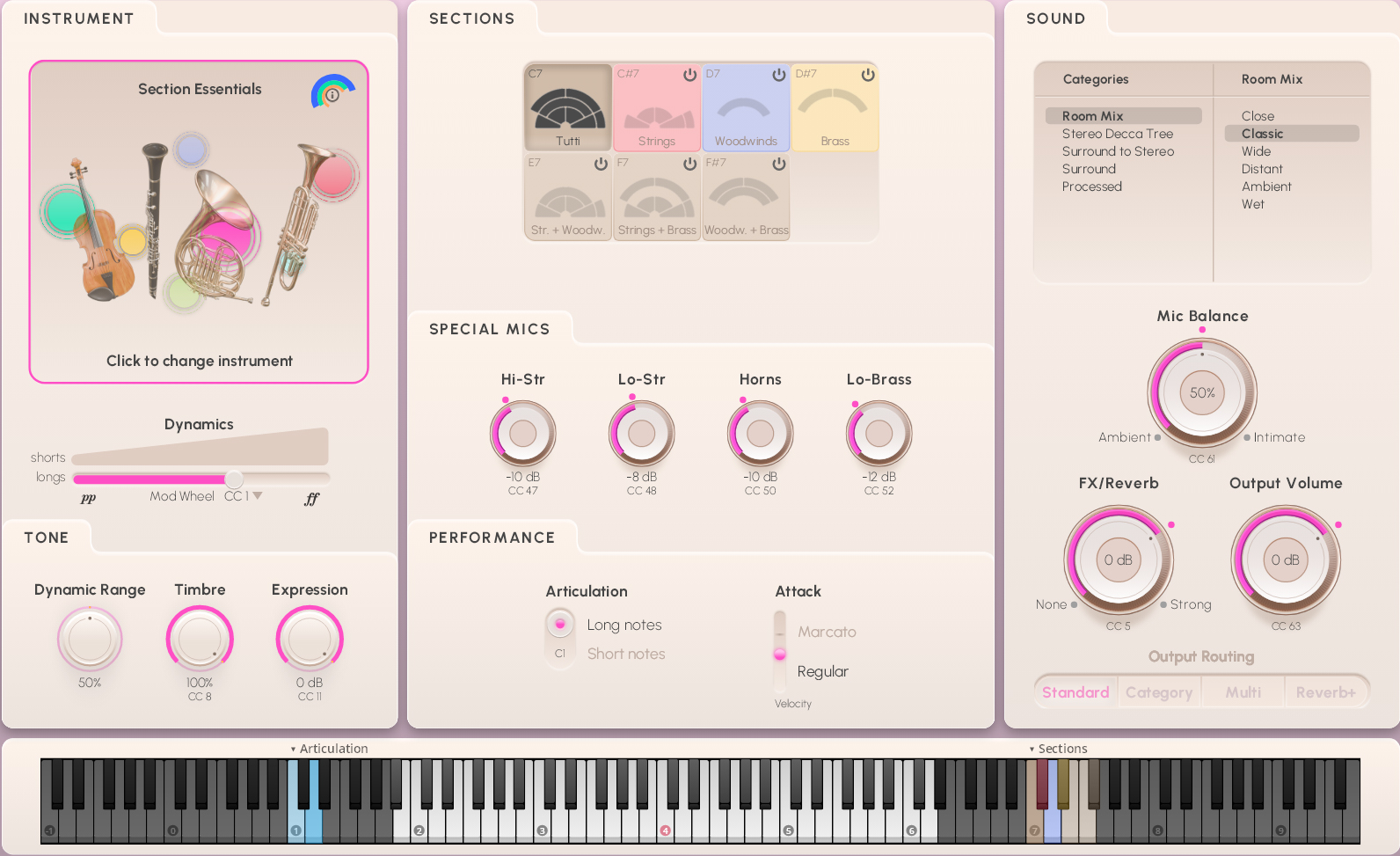
Attention:
As the left hand panels of every preset are very similar, they are treated in this general introduction, and will only be mentioned in the individual groups’ descriptions if there are significant differences. The right hand panels are all the same and therefore are also explained here.
The Instrument section is roughly the same for all instruments, with some variations that will be explained for the instruments concerned in the respective chapters. The field always shows a symbolic image of the selected Instrument, headed by the name of the loaded Preset. Below there’s an example of the Tutti High Strings preset. You can return to the Flow Browser to select another instrument by clicking on the Instrument field.
The Dynamics fader under the instrument normally is set to the modwheel (MIDI CC 1) or keystroke velocity by default, depending on the selected articulation – with the long notes used in the example below, it is the modwheel, meaning that you can influence the volume of a note being played by changing the controller value. You could also set it to a breath controller (MIDI CC 2), leaving your hand free for other stuff. Staccatos and pizzicatos, e.g., are set to keystroke velocity, as changing the volume of short notes while they are sounding hardly makes sense.
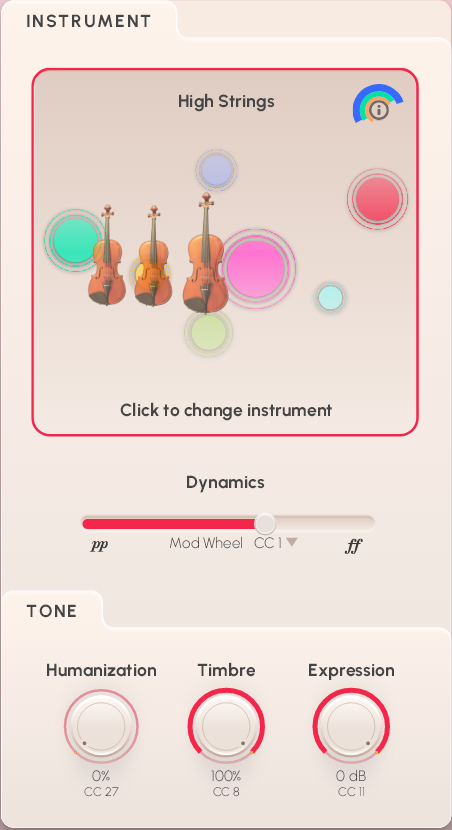
In the Tone field, you get access to other items which may be an important factor in making your piece sound truly alive. Mostly, these are:
Humanization (MIDI CC 27) lets you determine the percentage of not being exactly on time – a kind of counter-quantization that introduces an element of necessary imperfection.
Some instruments (e.g., the BBO 2 Woodwinds) have a Dynamic Range knob instead of Humanization that allows you to widen or narrow the instrument’s dynamic range.
Timbre (MIDI CC 8) affects the tone of the instrument, making it sound brighter or darker.
Expression (MIDI CC 11) is an additional volume control defining a percentage of CC 7 (volume), and can be used for automation.
The panel in the middle can look quite different depending on the loaded preset, so these will be treated in detail further below.
The upper field displays the possible choices – e.g., Articulation or orchestral Section – with their keyswitches, which are also marked on the Synchron Player’s virtual keyboard. Of course, you can also click on a button to switch to that articulaton. Articulation buttons are color-coded: orange for short notes, green for long ones, and blue for the universal articulation that allows you to perform without keyswitching.
Many Presets offer a Special Mics field that allows you to adjust the amount of individual sections.
The Performance field provides further options for the selected articulation, e.g., different attacks, A/B variants, or up and down movement of phrases.
The Sound panel is the same for all instrument groups of Big Bang Orchestra 2.0. You can select a basic Category on the top left, and one of the Mixer Presets from that category on the right. In the Processed category, you will find different room mix set-ups for different instruments.
Mic Balance (MIDI CC 61) adjusts the relation between ambient and intimate microphoning.
FX/Reverb (MIDI CC 5) sets the amount of reverb, which is different in intensity according to the selected preset.
Output Volume (MIDI CC 63) takes care of how much of what you do comes out of the Synchron Player.

The preset offers short and long notes played by all sections as well as in several combinations.
Instrument / Tone
The Instrument section has a dynamics meter for short notes, which are controlled by keystroke velocity, and a fader for long note dynamics controlled by the modwheel (MIDI CC 1).

Sections / Special Mics/ Performance
The upper field shows the selection of Sections with their keyswitches (C7–F#7), which are also marked on the Synchron Player’s virtual keyboard. Of course, you can also click on a button to switch to that articulaton.
In the Special Mics section of all tutti presets, you can control the amount of the individual microphones of high strings, low strings, horns, and low brass with MIDI CC 47, 48, 50, and 52.
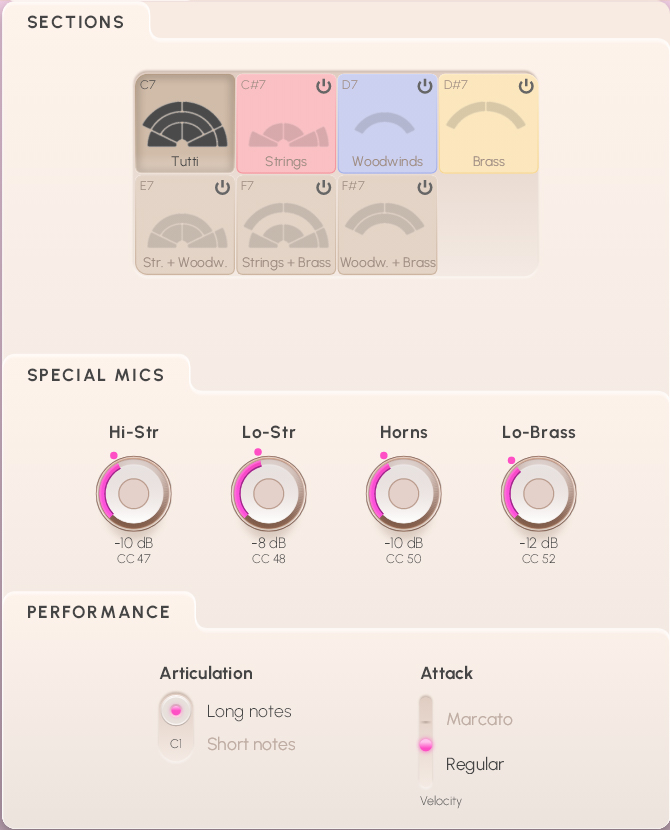
The Performance field contains the playing variants:
Articulation lets you switch between long and short notes with keyswitches C1/C#1.
Attack is set to keystroke velocity so that it will start with a marcato attack when you hit the key harder.
The preset features various short and long note articulations, trills, and falls.
Instrument / Tone
Other than the Section Essentials, the Instrument section here allows you to keyswitch between tutti without or with piccolo (A0/B0).
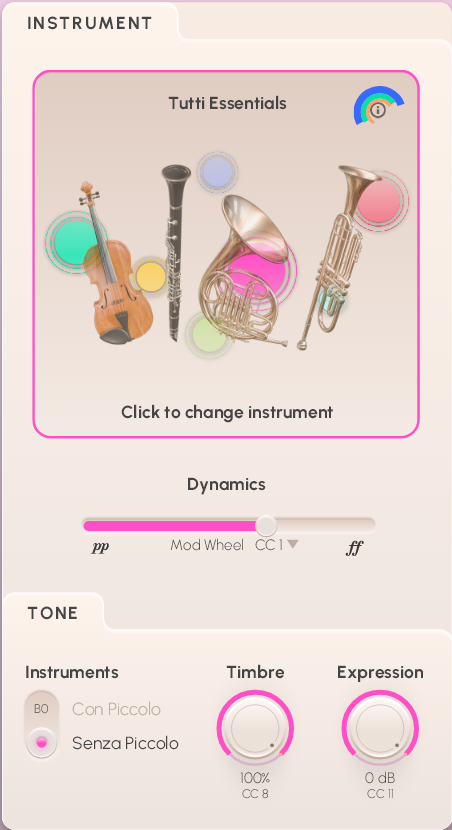
Articulation / Performance
The Articulation field contains the different articulation types, controlled by keyswitches (C1–A1).

The Performance field shows playing variants depending on the selected articulation. Here’s some examples:
The Attack of long notes, crescendos, etc. is set to keystroke velocity to produce different attack behaviour when you hit the key softer or harder.
Likewise, the Type of fast repetitions switches between staccatos and fast repetitions. The latter’s Tempo (120/140/160 bpm) can be controlled with MIDI CC 20.
Trill Interval uses keyswitches (C#7/D7) for half tone and whole tone trills.
Contains flams, graced notes, sforzato with pp sustains, and different chords.
Articulation / Performance
The Articulation field features the available articulations (keyswitches C1–G1).

In the Performance field, only the Direction of flams switches between upward and downward depending on keystroke velocity.
This preset offers phrases like runs and arpeggios, and several effects sounds.
Articulation / Performance
The Articulation field contains the available articulations (keyswitches C1–G1).

Two options are available in the Performance field:
The Direction of runs and rips switches depending on keystroke velocity.
Likewise, the Pulse of the microtuning articulation changes from slow to fast.
Short and long notes, short and long swells, moving clusters, and hits with pp sustain.
Articulation / Performance
Articulation keyswitches: C1–F1.
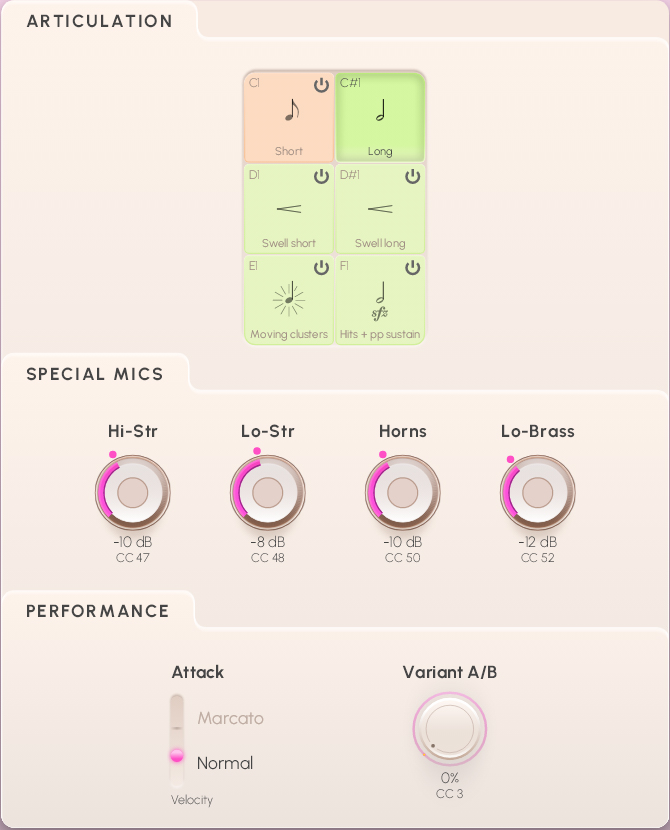
The Performance field has options depending on articulation:
The Attack of long notes, and short and long swells reacts to keystroke velocity.
In the moving clusters, keystroke velocity switches Type between Cluster to root and Root to cluster.
Some articulations have a Variant A/B option controlled with MIDI CC 3.
Staccato and long notes, tremolo and flutter tonguing, trills, runs, and a “universal” patch.
Articulation / Performance
Articulation keyswitches: C1–A1.

The Performance field has options depending on articulation:
The Attack of long articulations reacts to keystroke velocity.
Trill Interval uses keyswitches (C#7/D7) for half and whole tone trills.
The Mode of runs keyswitches between major and minor with C7/C#7.
The Direction of runs is controlled by keystroke velocity.
Short and long notes, and swells.
Articulation / Performance
Articulation keyswitches: C1–D1.
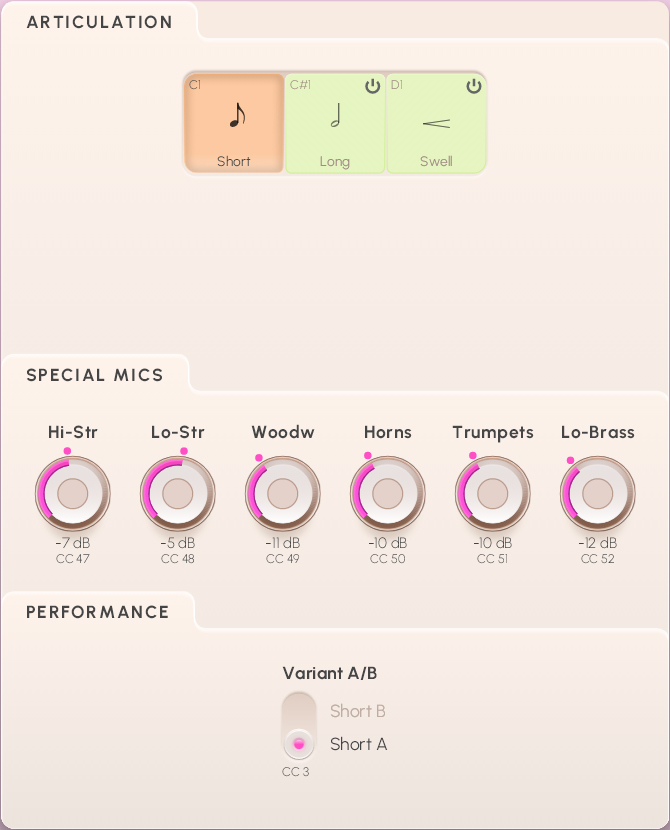
There are two options in the Performance field:
Variant A/B is controlled with MIDI CC 3.
The Attack of long notes and swells reacts to keystroke velocity.
Staccato, fast repetitions, pizzicato, long notes, dynamics, tremolo, trills, clissando, and a universal patch.
Articulation / Performance
Articulation keyswitches: C1–B1.
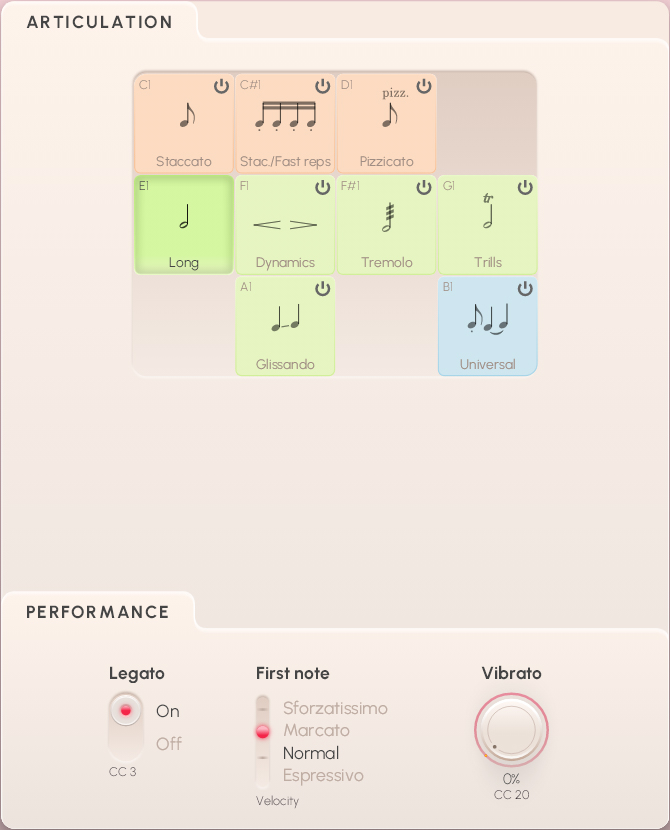
The Performance field features playing variants of the selected articulation:
The Legato option of long notes, trills, and others can be switched on and off with MIDI CC3.
Type control for articulations is mostly set to keystroke velocity. For instance, it switches between different short note articulations, or to first note variants for legato phrases.
Some articulations feature a Vibrato fader knob assigned to MIDI CC20, allowing you to “soft-switch” with a narrow crossfade area between samples without and with vibrato.
Release offers different release options, and is mostly used for switching between normal and cut release variants with the help of MIDI CC4.
If a performance button is controlled by keyswitch, the relevant note is displayed in the button’s “empty” part. This is used e.g. for short and long dynamics durations.
Instrument / Tone
Instead of a Humanization fader, the Tone section features a keyswitch for Hi-Low Mode, where you can set the sections’ ranges to overlap, or to be divided at C4.
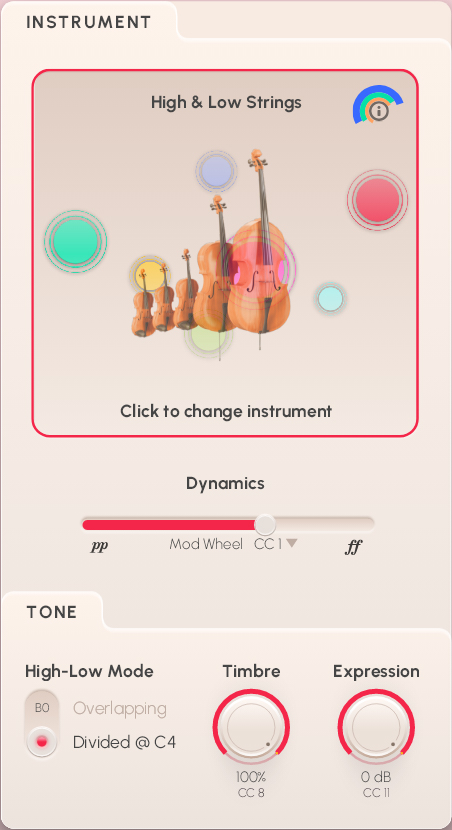
Articulation / Special Mics /Performance
In addition to the Articulation and Performance fields, there is a Special Mics section where you can control the amount of the high and low strings’ close microphones to fine-tune their relative volumes (MIDI CC 48 and 49).
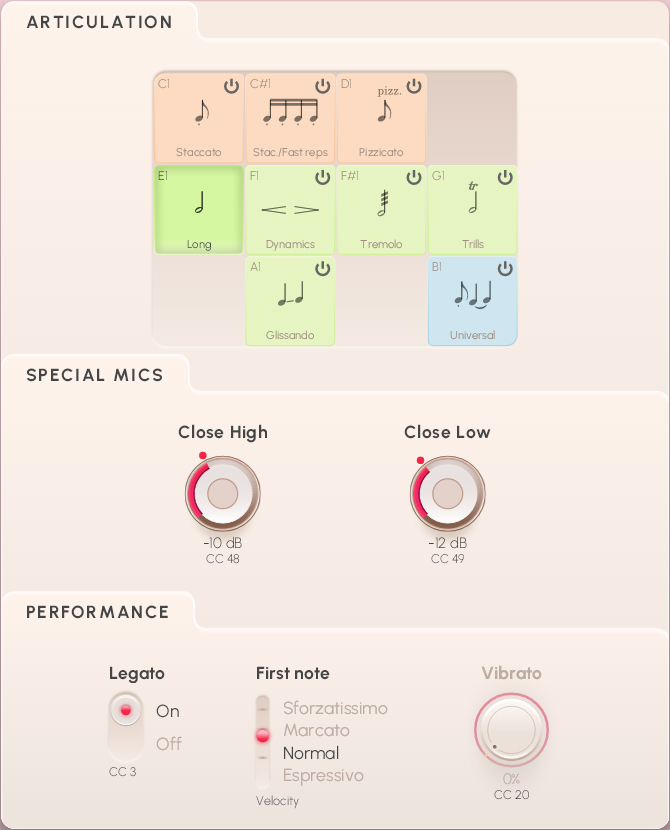
There are individual Presets for each of the string orchestras ensembles – 1st violins with 30 players, 2nd violins 26, violas 20, violoncellos 22, and double basses 14.
Articulation / Special Mics / Performance
This contains less articulations than the high and low strings presets, but offers a Special Mics section where you can adjust the amount of the featured instrument's Solo volume with MIDI CC 49.
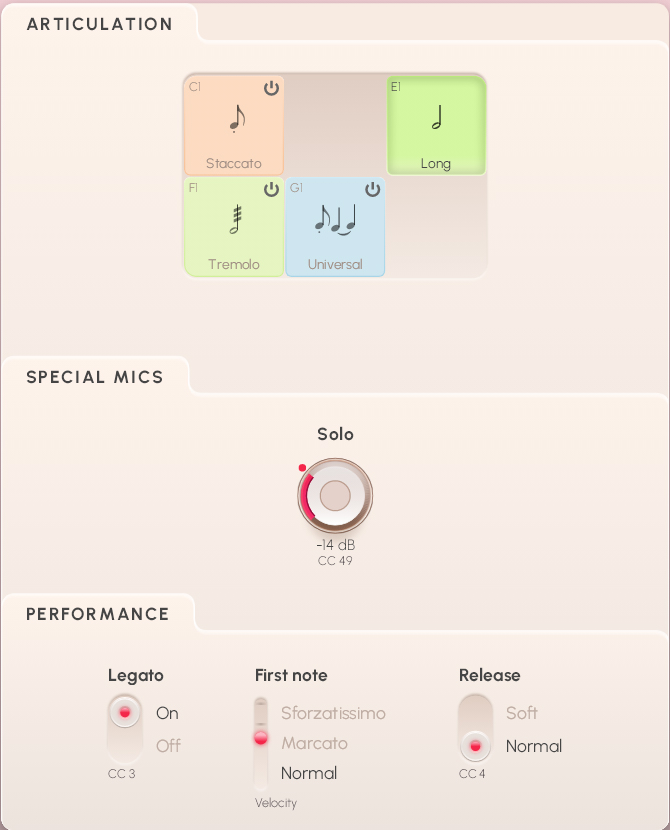
These two Presets differ only in their playing range. In Full Range, the instruments are mapped to their actual sounding notes, so that the playing range covers more than 6 octaves. In Compressed Range, mappings are shifted so that all the strings take up only 4 octaves. Thus, you can also play the strings orchestra on a smaller keyboard.
Articulation / Special Mics / Performance
The Special Mics section here gives you access to the sections’ solo microphones with MIDI CC 49, 52, 55, 58, and 60.
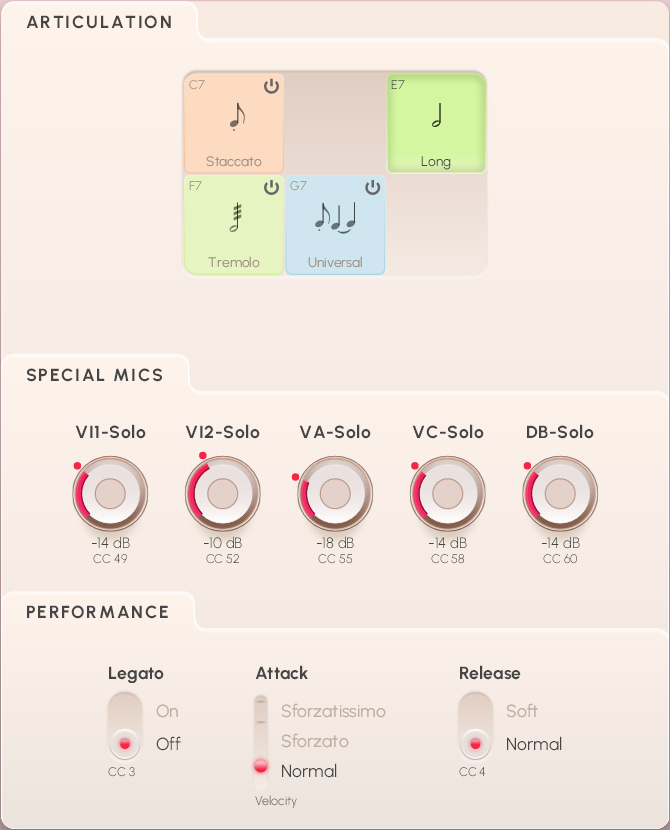
Presets for Tutti, High Woodwinds, and Low Woodwinds & Clusters.
The preset provides access to various short and long note articulations, fluttertongue, and trills.
Instrument / Tone
In the Instrument section, you can keyswitch between tutti without or with piccolo (A0/B0).

Articulation / Special Mics/ Performance
Articulation keyswitches: C1–G#1.
The Special Mics field lets you adjust the close microphone amounts of flutes, oboes, clarinets, and bassons with MIDI CC 48–51.
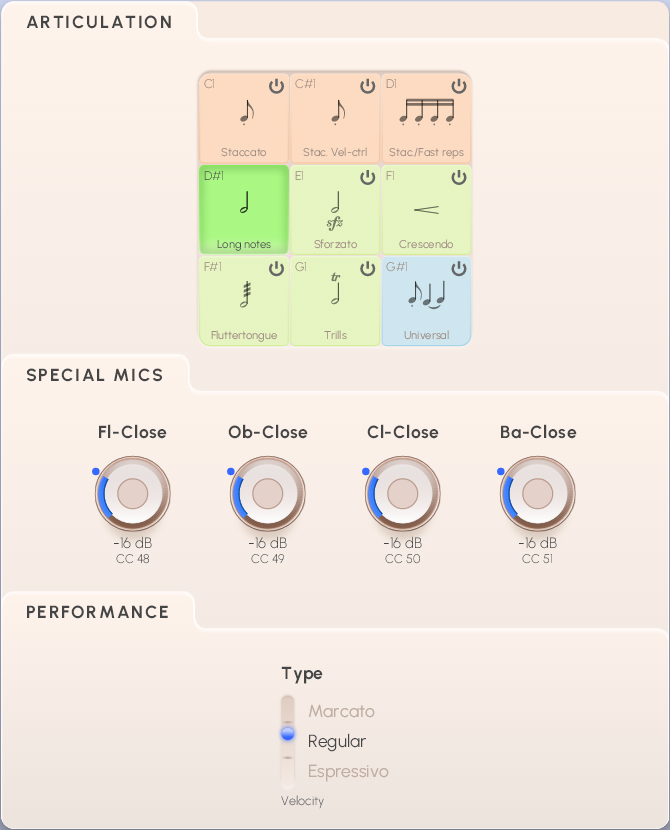
There are several options in the Performance field. Here are some examples:
Type is controlled by keystroke velocity and switches between, e.g., staccatos and fast repetitions, or the long notes’ espressivo, regular, and marcato articulations.
The Duration of crescendos switches between 1.5 seconds, 3 seconds, and soft swell with C1–D1.
Trill Interval is also controlled by keystroke velocity.
The preset features flute, oboe, and clarinet.
Articulation / Special Mics/ Performance
Articulation keyswitches: C1–D#1.
The Special Mics field lets you adjust the close microphone amounts of flutes, oboes, and clarinets with MIDI CC 48–50.
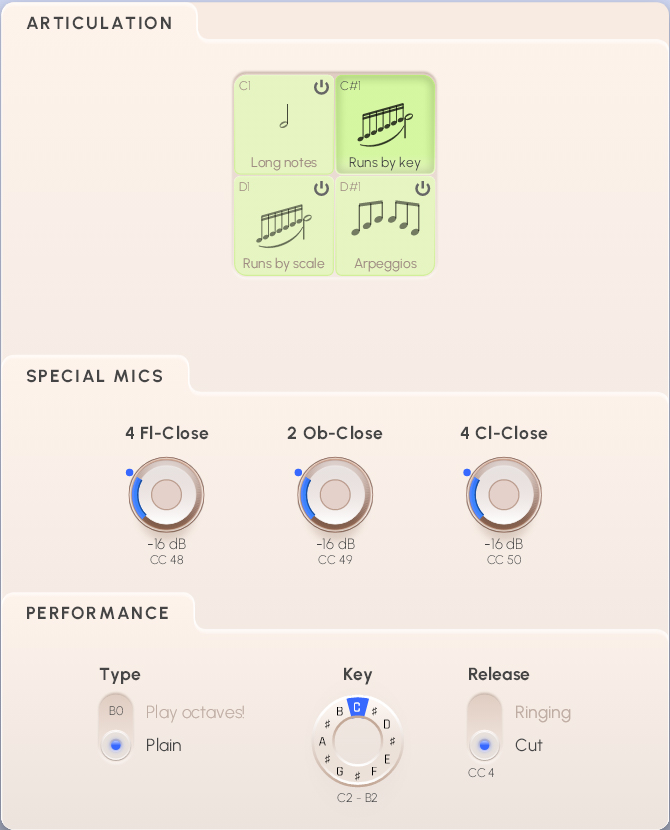
There are options in the Performance field for runs and arpeggios:
Use the Type keyswitches A0/B0 to select plain runs at fixed speeds, or play them yourself.
The controller named Key (runs by key on major scales), Mode (runs by scale: Ionian, Dorian, etc.), or Chord (arpeggios major, minor, etc.) serves to set these parameters with the help of keyswitches C2–B2 (keys), C2–G#2 (mode) resp. C2–G2 (chord).
The Release of plain runs can be set to ringing or cut with MIDI CC 4, that of arpeggios to cut, highest or lowest note.
The arpeggios’ Tempo can be set to 80/100/120 bpm or host-synchronized with the keyswitches F1–G#1.
Arpeggio Direction is set to up, down, or cross via keystroke velocity.
The preset features bass clarinets, bassoons, and contrabassoons.
Articulation / Special Mics/ Performance
Articulation keyswitches: C6–G#6.
The Special Mics field lets you adjust the close microphone amounts of bass clarinet, bassoon, and contrabassoon with MIDI CC 48–50.
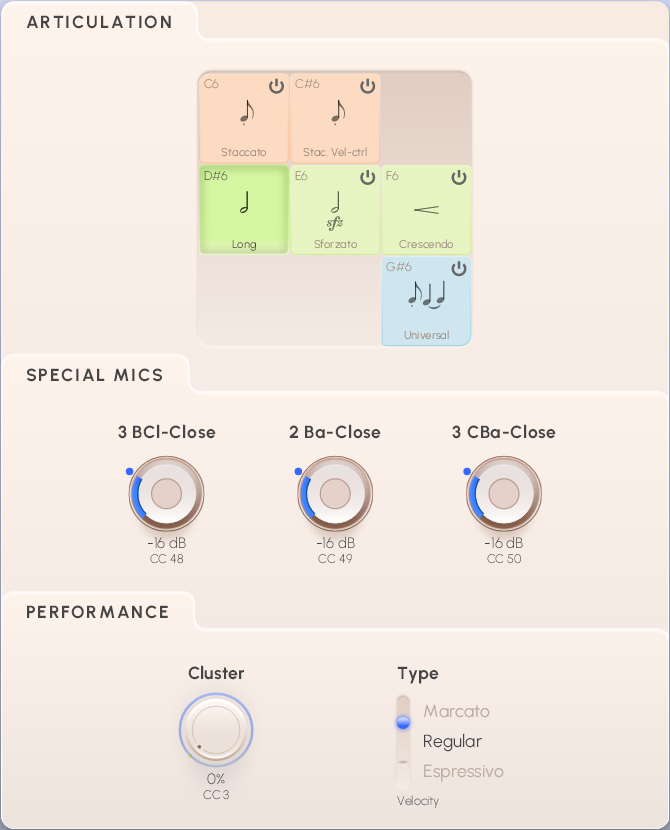
Here are some examples of the options in the Performance field:
Type is controlled by keystroke velocity and switches between, e.g., the long notes’ espressivo, regular, and marcato articulations.
Cluster spread can be adjusted with MIDI CC3.
The Duration of crescendos switches between 2 seconds, 3 seconds, and soft swell with C7–D7.
Presets for horn ensemble (12 players), trombone ensemble (9 players), low brass, and and Epic Legato combo.
Staccatos, long notes, sforzato, crescendo, rips (horns only), and a “universal” patch.
Articulation / Performance
Articulation keyswitches: C1–G#1 (horns), C6–G#6 (trombones).
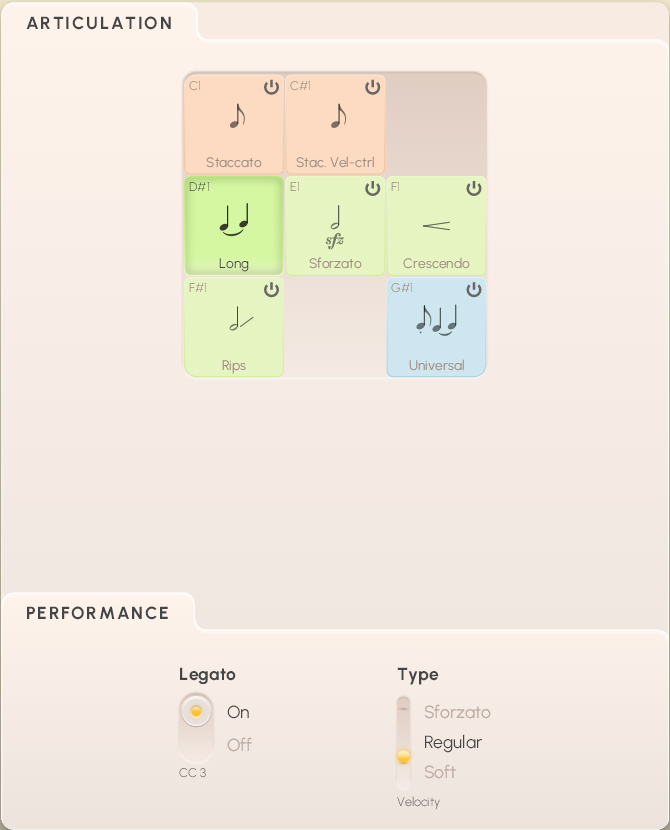
Performance options:
Type is controlled by keystroke velocity and switches between, e.g., the long notes’ soft, regular, and sforzato articulations. For the horns’ rips patch, it determines whether slow or fast rips are played.
Legato (horns only) is activated by default for long notes, sforzato, and crescendo, and can be deactivated with MIDI CC 3.
Switch the Duration of crescendos between 2 and 3 seconds with keyswitches C7/C#7.
Staccatos, long notes, sforzato, crescendo, fluttertongue, trills, and glissandos.
Articulation / Performance
Articulation keyswitches: C6–G#6.
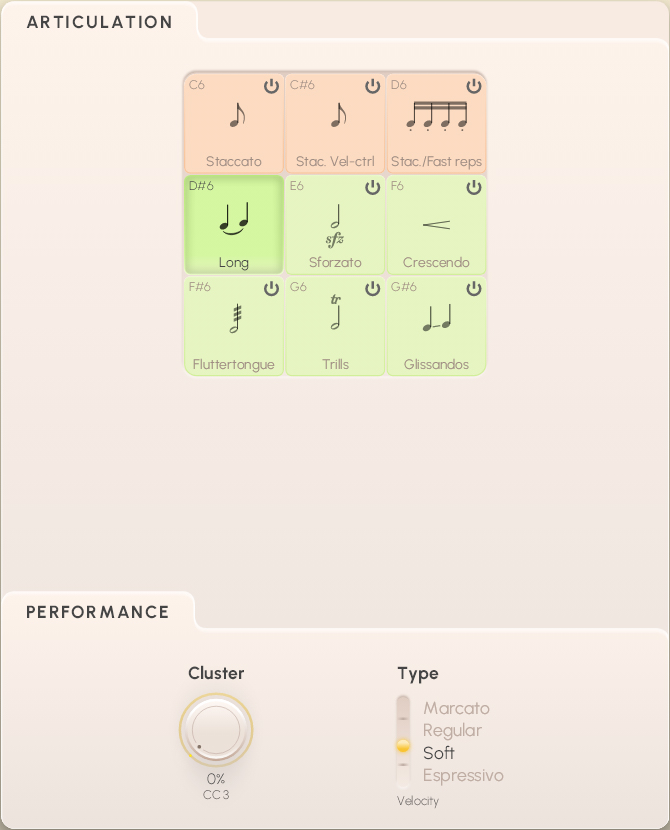
Performance options:
Type is controlled by keystroke velocity and switches between, e.g., the long notes’ different articulations.
Keystroke velocity also determines the glissando Interval of minor 2nd, major 2nd, or 4th.
Cluster spread can be adjusted with MIDI CC3.
Change the Duration of crescendos between 2 and 4 seconds with keyswitches C7/C#7.
This preset comprises woodwinds, horns, clarinets, violas, and violoncellos.
Special Mics / Performance
As there are only long and legato notes in this preset, the Articulation field does not require any entries.
The individual microphone amount of the 6 instrument groups can be adjusted with MIDI CC 47–52.

Performance options:
Legato on/off is set with MIDI CC 3.
Regular or soft Release can be selected with MIDI CC 4.
The percussion presets are largely the same, so that we’ll examine the first one in lieu of all. There are presets for Monster Drums, Bass Drums, Thunder Toms, Special Drums, Snare Ensemble, Suspended Cymbals, Super Crashes, Big Metal, Small Metal, Drums and Pianos, Big Timpani, Low Bells and Pianos, High Bells, and High Gongs.
As most percussion instruments do not play scales but rather show their versatility in beaters, materials, and different striking zones, the actual articulations are normally mapped to single keys. Mapping descriptions are displayed on top of the virtual keyboard; for a better view, click on the keyboard icon in the top left menu bar to open a separate Key Info window.
Odaiko, big taiko, big and small bass drum, and high and low surdo.
Instrument / Tone
The Instrument section has a dynamics meter for single hits, which are controlled by keystroke velocity, and – where applicable – a fader for rolls controlled by the modwheel (MIDI CC 1).

The Tone section has two fader knobs:
Dynamic Range (MIDI CC 31) allows you to widen or narrow the instrument’s dynamic range.
Expression (MIDI CC11) is an additional volume control defining a percentage of CC7 (volume), and can be used for automation.
Beaters / Special Mics /Performance
In the Beaters field you can choose between hard and soft beaters with the keyswitches C3/D3. Other presets may have other beaters: for instance, the Snare Ensemble offers sticks and hot rods.
Presets featuring chromatic percussion and pianos are mapped continuously over a certain keyboard range, and instead of beaters offer articulations like single hits and rolls.
The Special Mics field provides individual channels for the preset’s instruments to adjust their relative volume with MIDI CC 50–55; the number of channels in other presets naturally depends on the number of instruments.
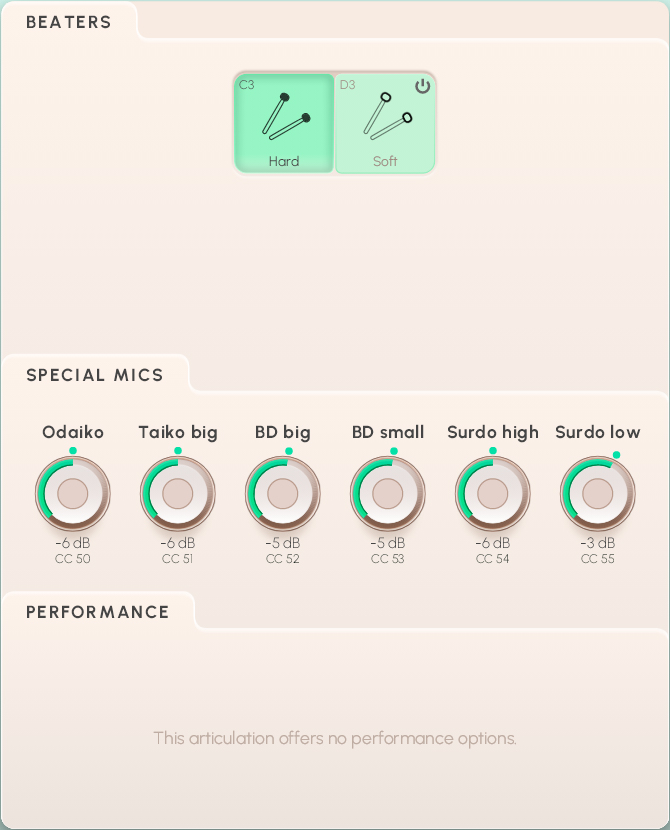
There are no Performance options for the purely percussive presets, but for those involving chromatic percussion and pianos:
Release can be secco or ringing, and is controlled with MIDI CC 4.
The soft and hard Beaters of Big Timpani are selected with C4/D4.
The presets include soprano, alto, tenor and bass ensembles solo and together, as well as a children's choir.
The Preset offers short and long notes, crescendos, chords, clusters, and a universal patch.
Articulation / Special Mics/ Performance
Articulation keyswitches: C7–F7.
The Special Mics field has separate channels for each choir section, allowing you to adjust their relative volume with MIDI CC 48–51.
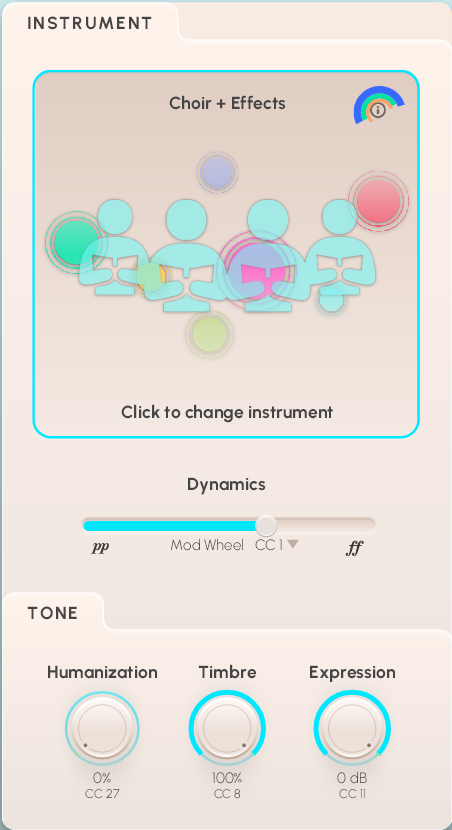
The Performance field offers playing variants according to articulation. Here’s some of them:
The Legato option of long notes and crescendos can be switched on and off with MIDI CC 3.
Type control for short notes switches between staccatos and shouts with keyswitches (A7/B7). For clusters there are five types (G7–B7).
Crescendo Duration of 2 or 5 seconds is also managed with keyswitches (A7/B7), as are major and minor chords.
The long notes’ First note and the clusters’ Attack options are set to keystroke velocity and range from espressivo to sforzato.
These Presets have the same layout and offer staccato and long notes, crescendos, and a universal patch.
In the Male and Female choir preset, the male singers are mapped in octaves from C2 to C4, the female singers from C#4 to D6.
Articulation / Special Mics / Performance
Articulation keyswitches: C7–F7 (white keys).
The Special Mics field has separate channels for each choir section, allowing you to adjust their relative amount with MIDI CC 48–51. The presets for individual ensembles also show all 4 channels to provide the authentic bleed information from the recordings.
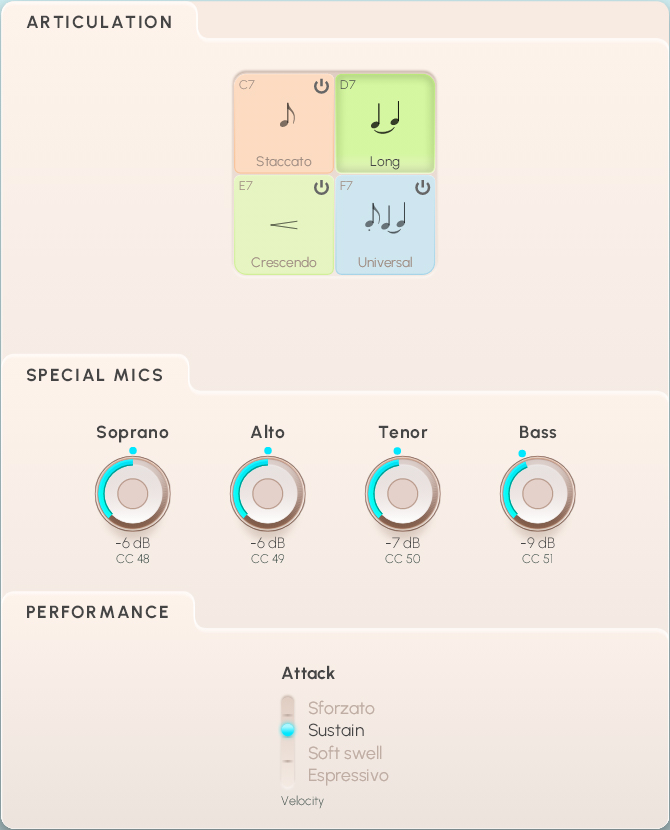
The Performance field offers playing variants according to articulation. Here’s some of them:
Legato (all except Full Range) of long notes and crescendos can be switched on and off with MIDI CC 3.
The long notes’ Attack is set to keystroke velocity and ranges from espressivo to sforzato.
Crescendo Duration of 2 or 5 seconds is set to keyswitches (A7/B7).
The children's choir has a different structure than the other ensembles and offers various vowel-consonant combinations.
Special Mics/ Performance
As there are only long notes/legatos, no articulation buttons are needed.
The Special Mics field Ribbon and Front Row channels with different sound qualities. You can fine-tune their relative amount with MIDI CC 48 and 49.
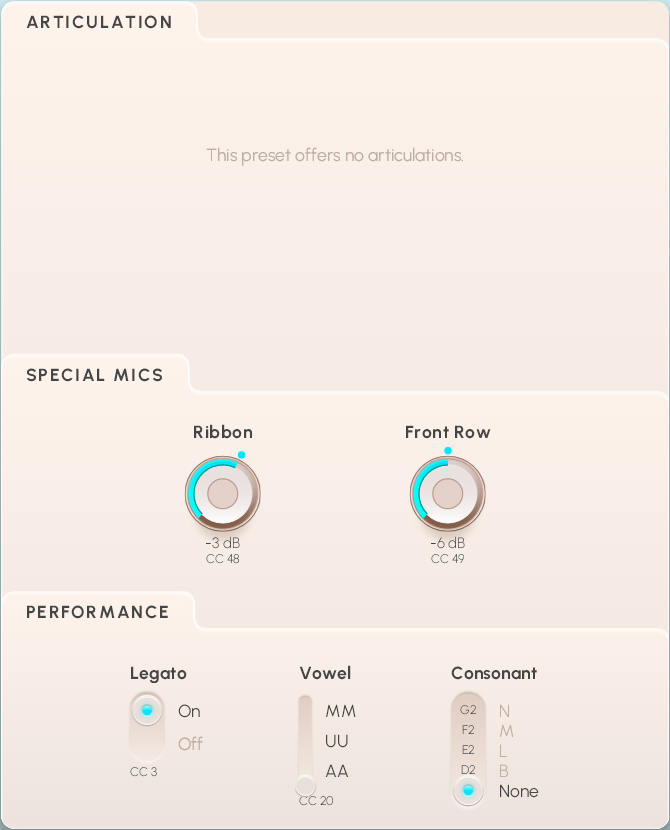
The Performance field offers the playing variants:
Legato can be switched on and off with MIDI CC 3.
Select the Vowel used (‘AA’, ‘UU’, ‘MM’) with the help of MIDI CC 20.
A Consonant (None/B/L/M/N) to precede the vowels AA or UU can be chosen with the keyswitches C2–G2 (white keys).
The presets consist of various instrument groups playing different riffs that can be combined and changed on the fly.
The riffs can be played at 120/130/140 bpm, or synched to the host’s tempo.
High and low strings, horns and low brass.
The Main riff is mapped from C3 to C5, the low and high riffs layered from C6 to C7.
Riffs / Special Mics/ Performance
The Riffs field shows selector circles for main, low and high riffs, each with 8 variations triggered by keyswitches. The selected rhythm is displayed underneath the selectors.
Main: D2–A2.
Low: D5–A5.
High: D7–A7.
The Special Mics field has separate channels for each section, allowing you to adjust their relative amount with MIDI CC 47/48 and 50/52.
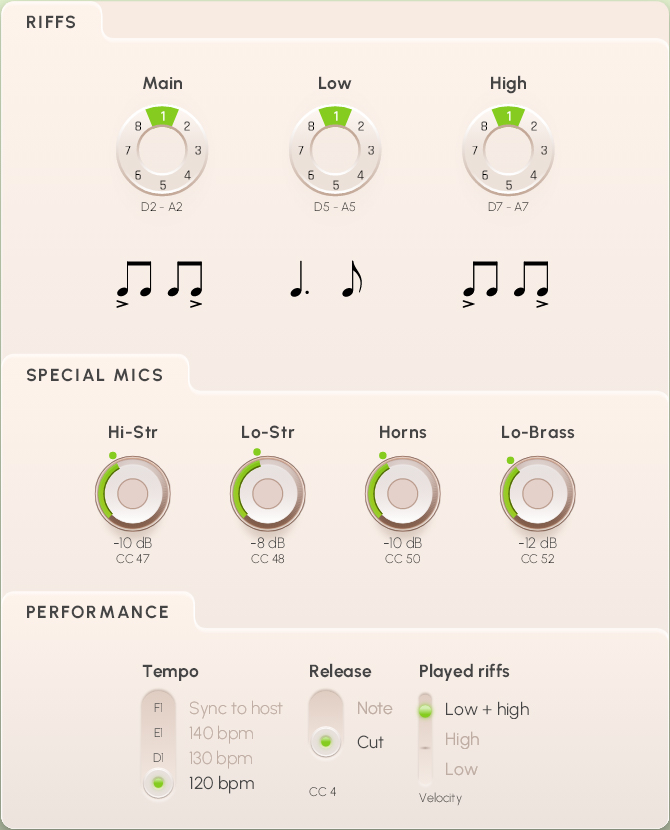
The Performance field contains tempo, release, and riff options:
Tempo is set with keyswitches C1–F1 (white keys).
Choose cut or note Release with MIDI CC 4.
The Played Riffs are controlled by keystroke velocity: a soft stroke will trigger only the low riffs, a medium one the high riffs, and a strong keystroke both.
Sync to host
The tempo setting "Sync to host" requires more CPU power than the fixed tempos. We recommend using "timestretch" Mixer Presets in combination with "Sync to host", because they need less resources.
Sections as above, with an option to crossfade variations.
Riffs / Special Mics/ Performance
In the Riffs field there is a selector circle for 6 variations triggered by keyswitches. Numbers 1–3 are used in 4–6 to crossfade into one another with the activated XFade knob. The selected rhythm or XFade combination is displayed below.
Variation: D2–G2.
Riff XFade: MIDI CC 3.
As above, the Special Mics field has separate channels for each section, controlled with MIDI CC 47/48 and 50/52.
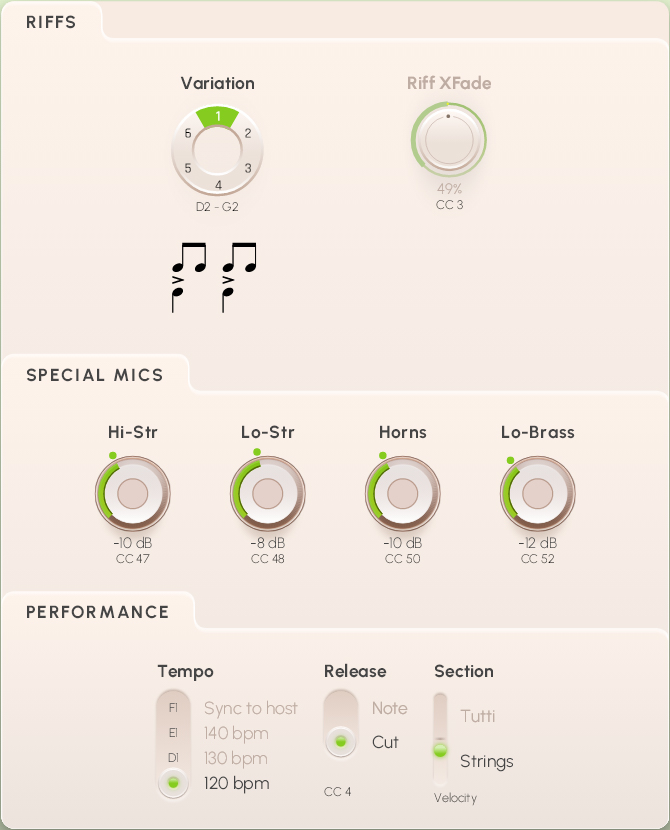
Performance options:
Tempo is set with keyswitches C1–F1 (white keys).
Choose cut or note Release with MIDI CC 4.
The Sectionss are controlled by keystroke velocity: a soft stroke will trigger only the strings, a strong one the tutti.
The preset features a big taiko, odaiko, bass drum, and 2 toms.
The loop variations are each mapped to C4 (cut release), C#4 (note release), D4 (single stroke).
Riffs / Special Mics/ Performance
In the Riffs field, the Main selector circle provides 8 variations and 1 combined mapping of all variations, triggered by keyswitches. The Variant selector offers different rhythm options for Main variation 1.
In the “all riffs” variant of the Main selector, loop variations are mapped from C3 to G7, always starting on C and F.
Variation: D2–A#2.
Variant: G1–A1.
Special Mics: separate channels for each drum, controlled with MIDI CC 51–55.
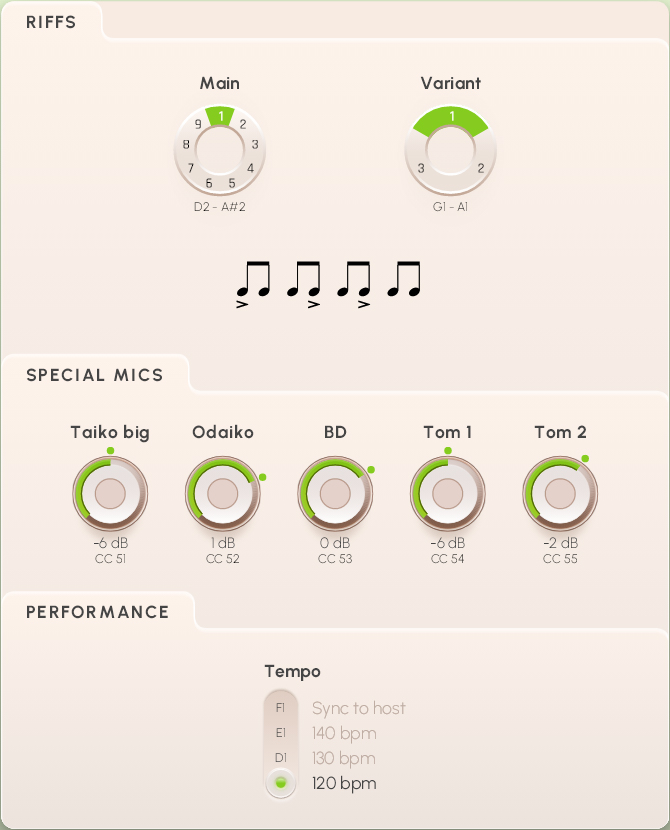
Performance options:
Tempo is set with keyswitches C1–F1 (white keys).
Configured like the Percussion Riffs (without the Variant selector), these presets also have 8 variations and 1 combined mapping (C4 to G7).
The High Riffs feature special mics for high tom, snare drum, cymbal, conga, and bongo.
Beater: use the keyswitches A0/B0 to select sticks or brushes.

On this page
- Introduction
- Instrument / Tone
- Articulation / Performance
- Sound
- Tutti Presets
- Section Essentials
- Tutti Essentials
- Tutti Hits
- Tutti Phrases & FX
- Tutti Clusters
- Sordino Essentials
- Con Sordino Clusters
- Strings Presets
- High Strings, Low Strings
- High & Low Strings
- String Sections
- Tutti Full Range, Tutti Compressed Range
- Woodwinds Presets
- Woodwinds Tutti
- High Woodwinds
- Low Woodwinds & Clusters
- Brass Presets
- Horns-12, Trombones-9
- Low Brass
- Epic Legato Combo
- Percussion Presets
- Monster Drums
- Choir Presets
- Choir + Effects
- Choir – Full Range, Male and Female, Sopranos, Altos, Tenors, Basses
- Children’s Choir
- Riffs Presets
- Symphonic Riffs
- Symphonic Riffs Expansion
- Percussion Main Riffs
- Percussion Low Riffs, Percussion High Riffs